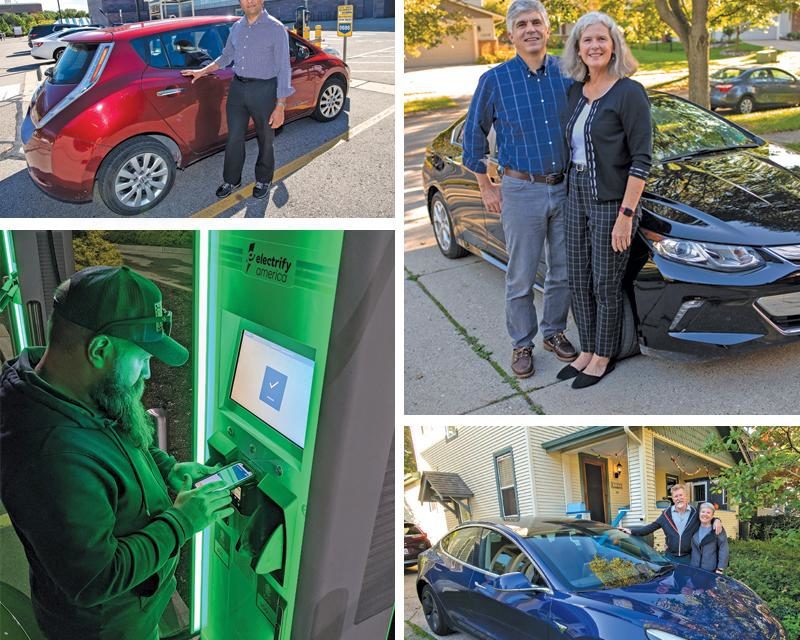Last year, California announced that it will ban the sale of new vehicles powered by internal combustion engines by 2035. In September, New York state set its own zero-emissions deadline at 2030.
U-M engineering and computer science professor Sandeep Pradhan is way ahead of them: he’s been commuting to North Campus in an electric Nissan Leaf since 2013. Though he also has a Toyota Prius hybrid, he says electric vehicles are twice as efficient–the EPA rated his Leaf at the equivalent of 115 miles per gallon. Their large batteries make EVs more expensive than similar-sized internal combustion cars–the Leaf was the first family car he could find under $40,000–but for someone concerned about climate change, it was worth it.
But being an EV pioneer isn’t painless. “I am an early adopter of this technology,” he says, “and my car goes only ninety miles” before its battery needs to be recharged–and even less in the winter.
Pradhan has a 220-volt charger in his home garage and charges every night, so “it’s fine for commuting,” he says. His normal round trip, including dropping his kids off at school, is only about thirty miles. “However, I cannot do anything else with the car for the day. For example, if my daughter has private violin lessons in Canton, then if I do that trip, then I would have range anxiety.”
He used to have a solution for that: charging at work. “Before Covid hit, it was great,” he says: he would park in one of two dedicated spaces in the lot by the Walgreen Drama Center and plug in.
But when he returned to campus this summer, only one of the chargers was working–and by October, neither was.
“I think they maybe want to get rid of it,” says another North Campus faculty member who asked to remain anonymous. He doesn’t have to worry about getting stuck, because his Prius Plug-in also has a gasoline engine that kicks in when the battery is exhausted. But “I have to charge almost every day if I want to keep it fully electric,” he says.
“They keep saying that they will replace the antiquated equipment. It’s about nine years old. But they’ve done nothing. The university makes a big deal of its carbon neutrality. But this clearly is something they should be taking care of.”
—
Rick Fitzgerald, U-M’s assistant vice president for public affairs, emails that some older chargers on campus “are no longer supported [by the manufacturer] with replacement parts.” That leaves just “11 charging spaces on the University of Michigan campus, including recent installations at the North Campus Research Complex and Wall Street East parking structures.”
The city is doing much better. Simi Barr, the city of Ann Arbor’s energy coordinator, says there are thirty free public chargers in downtown parking garages and twenty more for use by the city’s own EVs (the first battery-powered trash truck is coming next year). As the Observer went to press, the city was also preparing to activate four fast chargers at City Hall, “which is a huge step forward in public fast charging here in Ann Arbor,” he says. “Fast chargers like this can usually charge a vehicle up to 80 percent in around thirty minutes.”
According to Barr, “we saw around 2,000 electric vehicles in the Ann Arbor area this time last year. Our estimates are now close to 2,600 battery and plug-in electric vehicles in area.”
Four public fast chargers is not a lot relative to the number of people who might want to use them. And staying charged gets harder the farther they venture from home. As the editors of Ann Arbor-based Car and Driver magazine found during a 1,000-mile road trip last summer, keeping an EV powered can be a real headache (see The EV 1000, below).
That may explain why most of the electric-power pioneers we found didn’t depend solely on batteries. Most drive plug-in hybrid electrical vehicles (PHEVs) that have a gas engine to take over when the juice runs out.
—
Lisa Psarouthakis recently borrowed a friend’s van for a trip to the Traverse City area. “I came back and it was almost $60 to fill that tank,” Emerson School’s admissions director recalls. “I said, ‘Oh my God! This is crazy!’ Because we don’t use gas very often.”
She and her husband, Mike Psarouthakis, haven’t had to, because they’ve been driving Chevy Volt PHEVs for years. “I think we have had five Volts in total,” emails Mike, who heads the U-M’s Innovation Partnerships Venture Center. Until the lease ran out last spring, they also had a PHEV SUV: a Mitsubishi Outlander.
A DTE rebate paid for two fast chargers in their garage, and Mike can also use one of four chargers (“all operational,” he points out) at his office off Huron Parkway. Emerson doesn’t have any chargers, so Lisa charges at home.
Their first Volts could go about thirty-five miles on a charge during the summer, she says, their latest up to sixty-five. By keeping the batteries topped up, Lisa says, “we weren’t having to put any gas in them at all” around town. And on trips there’s never any range anxiety, because “as soon as your battery is used up, it automatically switches over to the gas-powered engine.”
It sounds appealing, but most drivers found PHEVs easy to resist. After years of disappointing sales, GM dropped the Volt in 2019.
The Psarouthakises, though, remain committed to the concept–at least until the charging situation improves and prices come down on long-range EVs. They just ordered a Toyota RAV4 Prime.
—
Ric Lawson and Kathy Stocking brought their Tesla Model 3 home in July 2020. They named it Greta, for Swedish environmental activist Greta Thunberg.
“Given her strength and wisdom, what she literally stands for, and our kids’ preferences, no other name was really in the running,” emails Stocking, a retired nonprofit executive.
“The biggest motivator is to get away from the internal combustion engine,” adds Lawson, a planner at the Huron River Watershed Council. “Cars are a huge contributor to climate change,” he writes. After a Ford Escape hybrid and a Chevy Volt, “getting a full electric is a small step we can make toward reducing our impact and to serve as an example that things can be different.”
It’s a bonus that it’s fun to drive. “The instant torque and acceleration [were] a surprise,” Lawson emails–and “while it is not the full solution to our carbon footprint, it is a good start.”
But they kept their Honda CR-V. “We have that for trips that require more hauling, storage, or equipment,” Lawson explains. And he and their son took it on a trip to the U.P. this spring instead of the Tesla, because “there is a huge gap in the charging network up there.”
“Kathy initially had some serious range anxiety before she took a solo trip to Chicago,” Lawson admits. But “Greta made it so easy, by automatically scheduling where and when to stop and charge and for how long. She’s now ready to go anywhere with me, thanks to the supercharging network.”
He tells potential EV owners worried about running out of juice to “check those fears. Look at the map of available charging stations–especially superchargers. They’re everywhere, and I believe that Tesla is opening the tech on those stations so that, soon, other makers will be able to incorporate supercharging speeds. That gets you from close to 0 to 85-90% charge in about a half-hour–less than the time to get in line and order a meal or a coffee. Plus, think about the energy you are saving and the fun you are missing. Get on board the electric train … or car! Don’t get left behind. Be part of the solution.”
—
The North Campus engineers are still wondering when they’ll be able to charge at work again. Just this past May, a report from President Schlissel’s Commission on Carbon Neutrality placed it at the center of the university’s mission.
Engineering and physics prof Stephen Forrest, one of the commission’s cochairs, says he isn’t making excuses for the present, but “the point of the commission was to point a direction to the future.”
He’s confident that the commitment will survive Schlissel’s departure. “We put in our report that [any] decision on hiring university leaders should be based on their commitment to this process,” he says. “I don’t want to sound glib, but the way the world is going, there isn’t latitude for backing down. Our report was extremely aggressive, and Schlissel basically said yes to everything.”
But on-campus charging for commuters is a low priority. The first “scope,” Forrest says, is getting the energy the university uses from renewable sources. The second is reducing carbon emissions from suppliers. Emissions outside the university’s control–like commuting–are scope three. They won’t even have a plan for addressing those till 2025.
Pradhan is undaunted. Getting the most from his Leaf’s feeble battery makes him “more aware of how much energy I am using, commuting,” he emails.
Besides, he adds, “electric cars are really fun to drive.”
—
The EV 1000
Why would anyone try to drive eleven EVs 1,000 miles? “Because a thousand miles sounded cool,” says Sharon Carty, editor-in-chief of Car and Driver.
For the Ann Arbor-based magazine’s first “EV of the Year” test, Carty and twenty-one colleagues raced from charger to charger across four states to find out, as Eric Tingwall wrote in the July/August issue, “what it’s like to drive long distances in 2021” on battery power.
For anyone expecting something like Monaco or Daytona, Tingwall cautioned, “It looks more like race-walking.”
Carty, in the Tesla Model Y Performance, brought her acoustic guitar to pass the time while the car was charging. Staff editor Drew Dorian, in the Audi e-tron, brought a fifty-foot extension cord, just in case. The other entrants were a Tesla Model 3 and Model S; a Porsche Taycan; a VW ID.4; a Polestar 2; a Nissan Leaf Plus; a Kia Niro EV; and the car that would go on to win EV of the Year, a Ford Mustang Mach-E.
The Ford didn’t win the race, though. After a strong start, wrote Tingwall, “a spectacular string of charging failures” left it limping through Pittsburgh at fifty miles an hour with low-battery warnings glaring. Teslas took all three top spots–only to lose the title due to various defects and deficiencies.
“Tesla’s sweep of the podium makes it clear,” Tingwall wrote: “If you want to regularly drive long distances in an EV today, you’ll want a car with access to Tesla’s proprietary charging infrastructure.” But when asked if they’d do the trip again, most agreed that they’d change one thing–they’d drive a gas car.
“Some people enjoy the challenge” of EV road trips, Carty says. “They are doing what they believe is a really good thing for the environment, and it’s good for the planet, so all of this is part of that fun, and it makes them feel good.
“But for others, it’s just an added layer of stress. It just depends on your tolerance.
“Our thousand miles showed weaknesses in the infrastructure, even the Teslas. We need to up our game, charging station-wise. That’s the biggest challenge right now.”
—
Calls & Letters, December 2021
“I read with great interest your [November] article on EVs,” Joanna Schultz emailed. “My husband and I bought a used Fiat 500e about a year ago and although we love our zippy little EV, we’ve encountered two issues your article didn’t address.”
The first was a problem that kept the battery from fully charging. The second that the nearest Fiat mechanic certified to work on electric cars “is over an hour and a half away in any direction.”
In “trial and error fashion,” Schultz writes, the couple hired an electrician to install a high-speed charger and “solve some ‘flow’ issues” in their household current. They “still have times occasionally when the charging stops mid-charge and we have to scramble a bit to get it going again,” she writes—but so far, they’ve “managed to avoid any trips to a Fiat 500e mechanic.”





